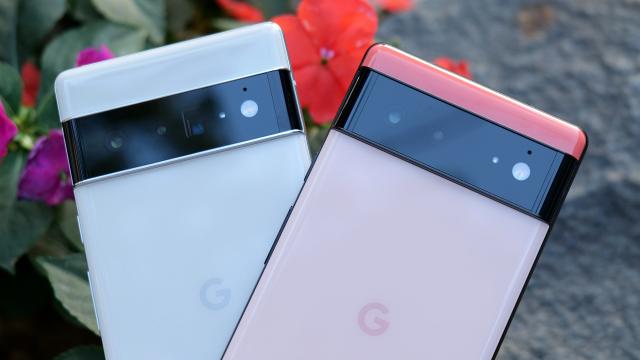Google packed the Pixel 6 with a ton of new features, starting with a custom-built processor called Tensor, but perhaps an even bigger deal is its cameras. The Pixel lineup has always been known for Google’s AI-powered photography featured, and the Pixel 6 gets a serious upgrade.
With the new Pixel, Google added the biggest main sensor (50-MP) ever put in a Pixel, and also added a dedicated 4x optical zoom on the Pixel 6 Pro. The Pixel 6 Pro is actually Google’s first phone to feature an ultra-wide rear cam and a dedicated zoom cam in the same handset.
But smartphone cameras are all getting better, and megapixel count doesn’t tell the full story. Apple’s iPhone 13 Pro has some neat camera tricks, and the Samsung Galaxy S21 Ultra’s zoom is wildly impressive. Here’s how the trio of flagships’ cameras compare.
Note: We used the Pixel 6 Pro as our test phone in this comparison, as the Pixel 6 and Pixel 6 Pro share the exact same 50-MP main cam and 12-MP ultra-wide cam, while the Pixel 6 Pro gets a bonus 48-MP telephoto cam with a 4x optical zoom.
Pixel 6 Pro vs. Galaxy S21 Ultra
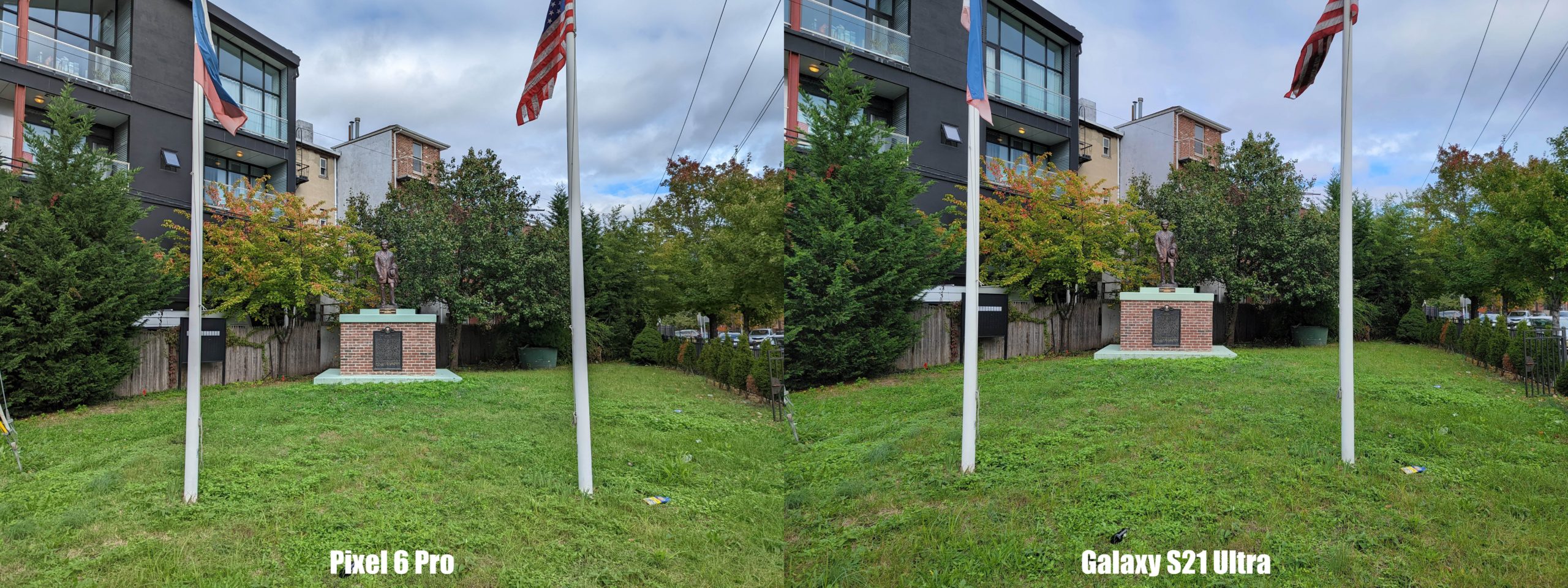
In this very normal shot of a statue, photos captured by the Pixel 6 Pro and Galaxy S21 Ultra are quite similar. However, if you look closely, you’ll notice that the Pixel 6’s shot features slightly more dynamic range, which allows the Pixel to retain more details in the grass and sky, while capturing even more vibrant and saturated colours. And that says a lot, because super rich colours are usually a strong suit of Samsung’s image processing.
Pixel 6 Pro vs. Galaxy S21: 4x Zoom
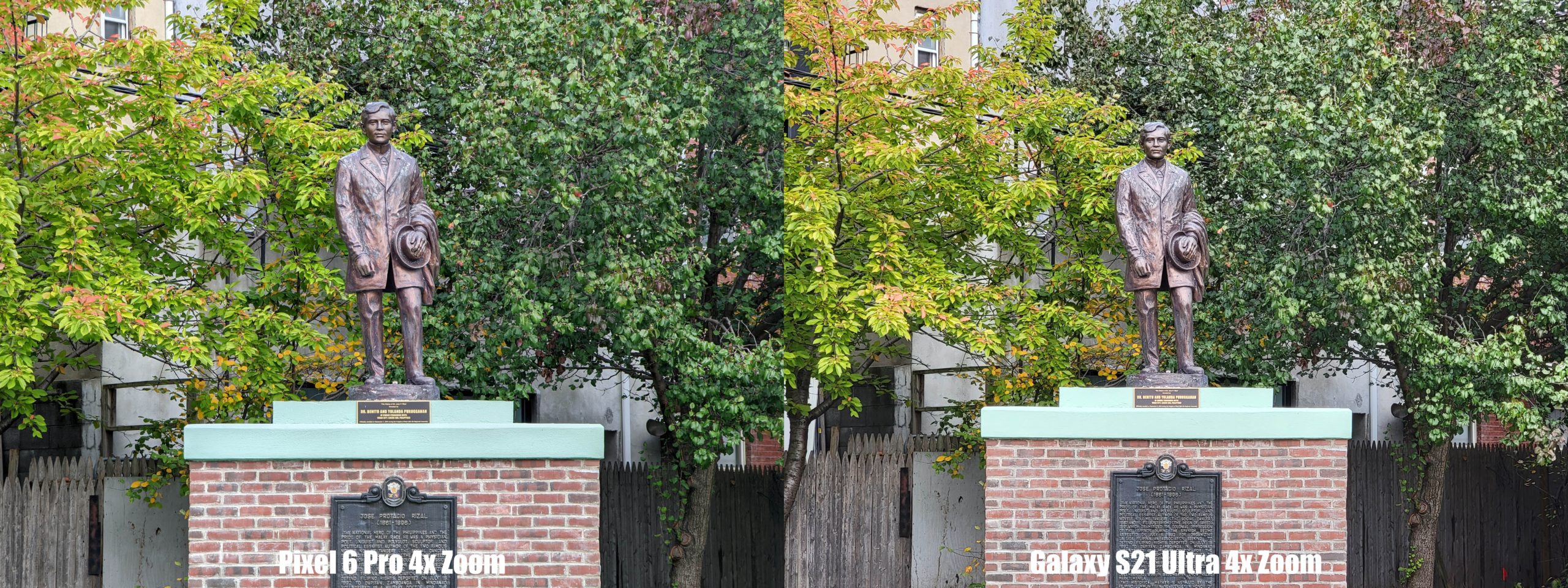
Without moving from the spot of the previous photo, this second picture shows off the 4x optical zoom on the Pixel 6 Pro, which provides a significant amount of extra reach without any tradeoffs in image quality. Even when compared to the more expensive Galaxy S21 Ultra, the Pixel 6 Pro’s pic looks just a touch sharper and richer.
Pixel 6 Pro vs. Galaxy S21: 20x Zoom
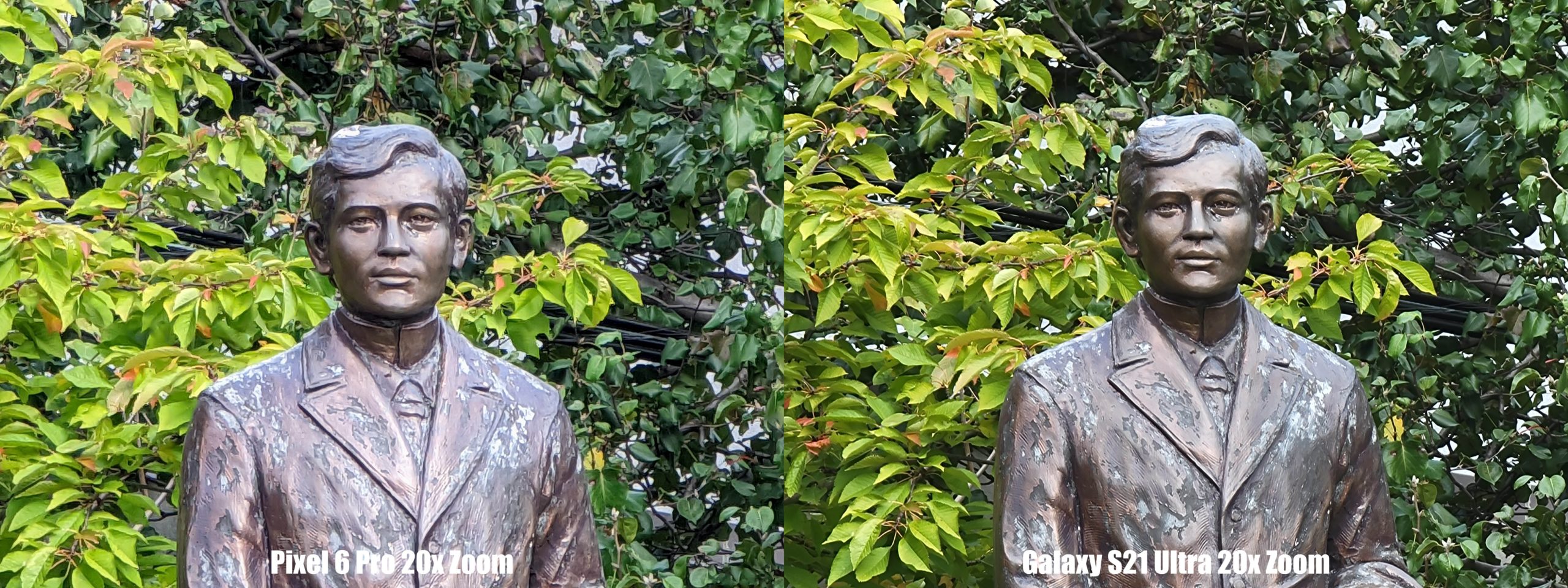
For people who want an even longer zoom, the Pixel 6 Pro is able to combine its 4x optical zoom with Google’s Super Res Zoom processing to provide a hybrid zoom of up to 20x. However, there’s a limit to how far you can magnify an image (even with fancy computational photography algorithms), and when compared to the Galaxy S21 Ultra, which features a 10x optical plus digital zoom, you can see that in terms of pure reach, the S21 Ultra still offers the longest and highest quality zoom you can get on pretty much any phone today. It’s close, but this time Samsung takes the win.
Pixel 6 Pro vs. iPhone 13 Pro: Colour Saturation
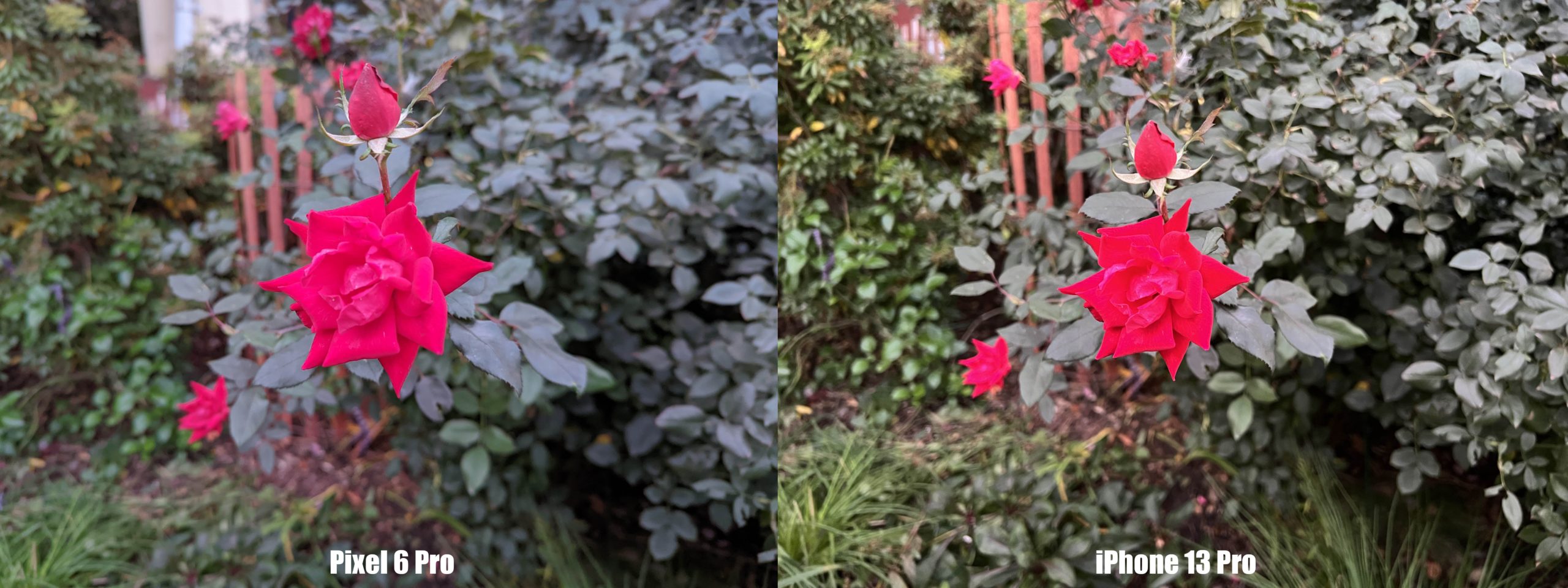
One of the most challenging things to balance on smartphone camera is capturing the bright, saturated colours that so many people gravitate toward without blowing them out. But as you can see here, one of the Pixel 6’s biggest strengths is the way it uses its HDR processing to capture tricky subjects like flowers while still retaining sharper details and textures, compared to the iPhone 13 Pro’s pic, in which the flower’s oversaturated petals begin to merge together.
Pixel 6 Pro vs. iPhone 13 Pro: Ultra-Wide
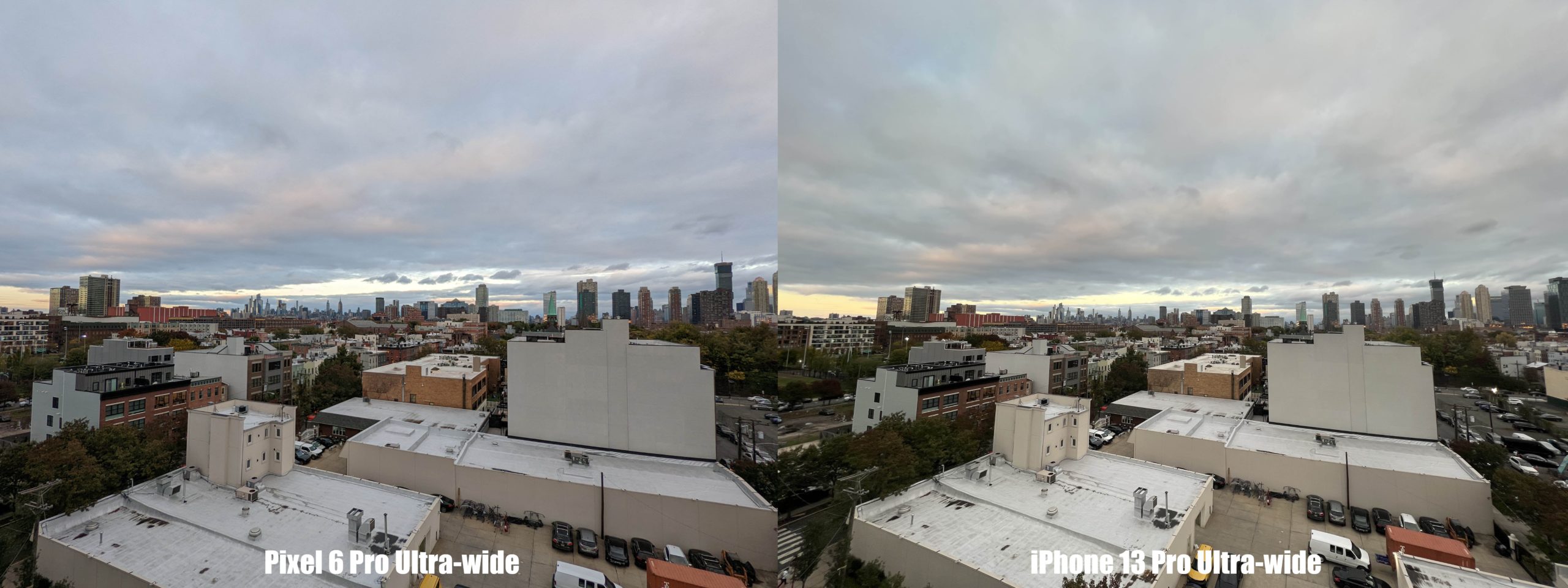
Ultra-wide cameras on phones have gotten pretty good as of late, but even so, when you can look at pictures side-by-side, a lot of differences become more apparent. In the Pixel 6’s photo, you can see its cooler white balance results in more pronounced blues. However, when compared to the iPhone 13 Pro, you can see that Apple’s phone has a slightly wider field of view, though that more expansive range does come with a bit less sharpness, which you can see around the edges of the iPhone 13 Pro’s pic.
But overall when it comes to detail, the Pixel 6 and iPhone 13 Pro are quite close, with the iPhone 13 possibly even having the lead when it comes to capturing all the details in the clouds.
Pixel 6 Pro vs. Surface Duo 2

While this slideshow is largely designed to pit the Pixel 6 against its biggest rivals, I wanted to take some time to show how the Pixel 6 fares against other phones to better illustrate how big of a gap there is even when compared to other super premium devices. Microsoft added a big new triple rear camera module to the Surface Duo 2, but it still struggles to deliver the kind of sharpness, dynamic range, and colour richness (especially in this shot), you get from the Pixel 6 Pro.
Pixel 6 Pro vs. iPhone 13 Pro: Low Light
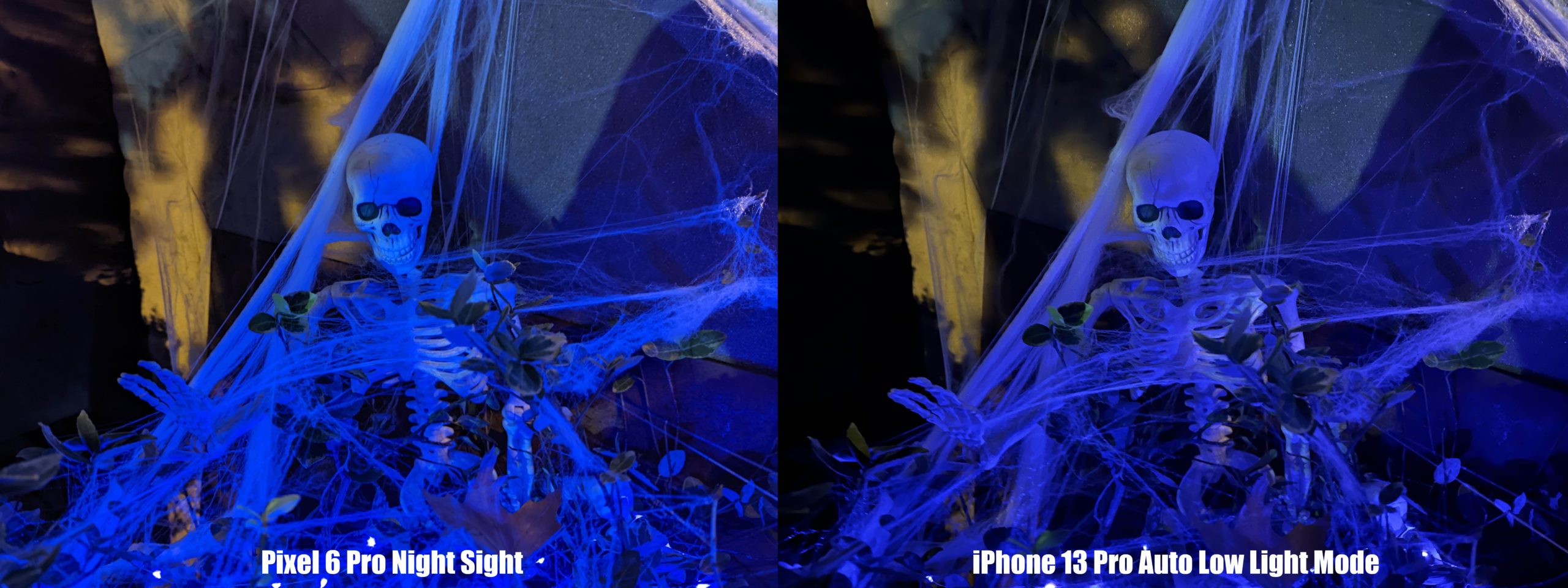
Spooky decorations make a great subject for camera comparison, particularly when there’s coloured lighting to make the scene even trickier. And in this shoot-out, both phones do a great job. The Pixel 6 captured a slightly better exposed shot, but the iPhone 13 Pro’s pic arguably has a tiny bit more detail. So instead of having a clear-cut winner, this head-to-head shows how varying conditions can bring out different strengths and weaknesses of a smartphone’s camera.
Pixel 6 Pro vs. Galaxy S21: Low Light
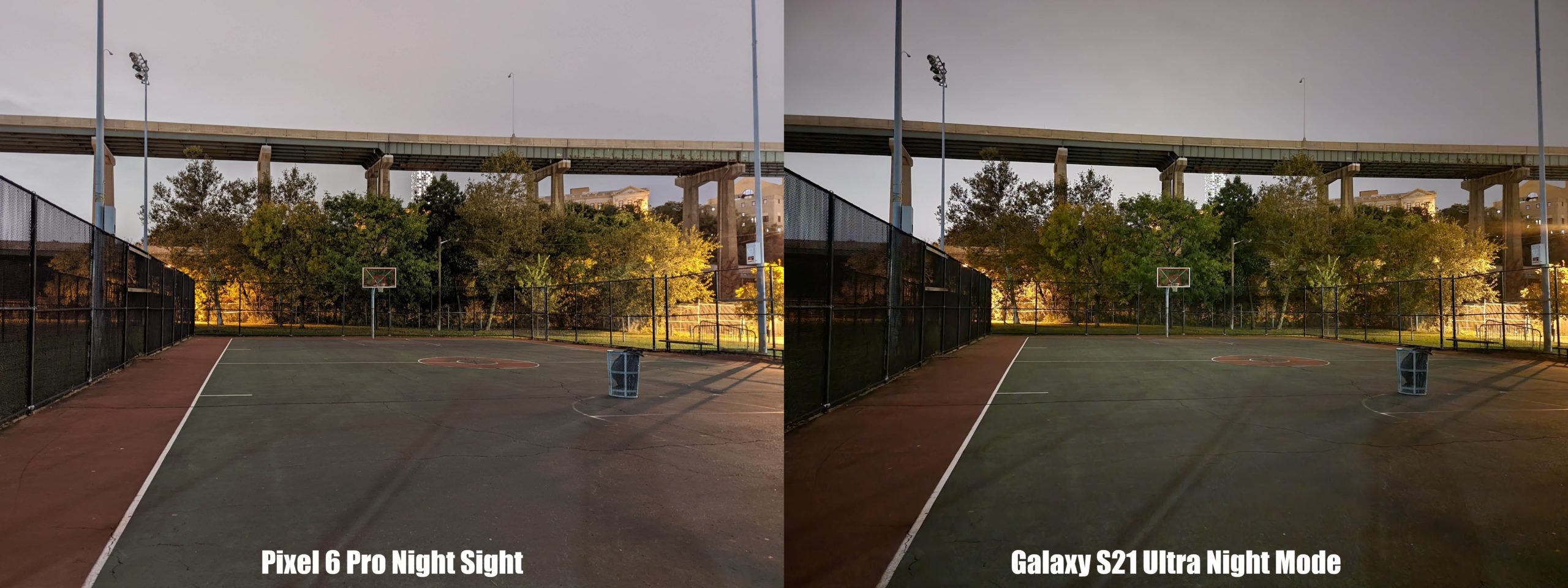
You’d probably be pretty satisfied with the S21 Ultra’s pic — that is, until you looked over at the Pixel 6 Pro’s shot, which is just a bit better in almost every way. Not only is the Pixel’s shot brighter, but it’s significantly sharper (check the leaves and trees in back), and it also captured finer textures on the asphalt.
Pixel 6 Pro vs. iPhone 13 Pro: Ultra Low Light

From the photo, you’d never guess that both shots were taken in a room with less than a single candle’s worth of light, but it’s true. And while the iPhone 13 Pro’s shot is definitely impressive when you consider it only has an automated low-light setting, things like the heavy vignetting (the darker sections in the corners of the photo) and less detail in the table’s wood surface makes the Pixel 6’s image the overall brighter, and possibly better, photo. (The iPhone’s vignette effect is cool though.)
I also want to point out that while both the Pixel 6 and iPhone 13 suffer from spots caused by lens flare (on the far right), the flare in the Pixel 6’s photos is just a bit less pronounced.
Pixel 6 Pro vs. Galaxy S21 Ultra: Ultra Low Light
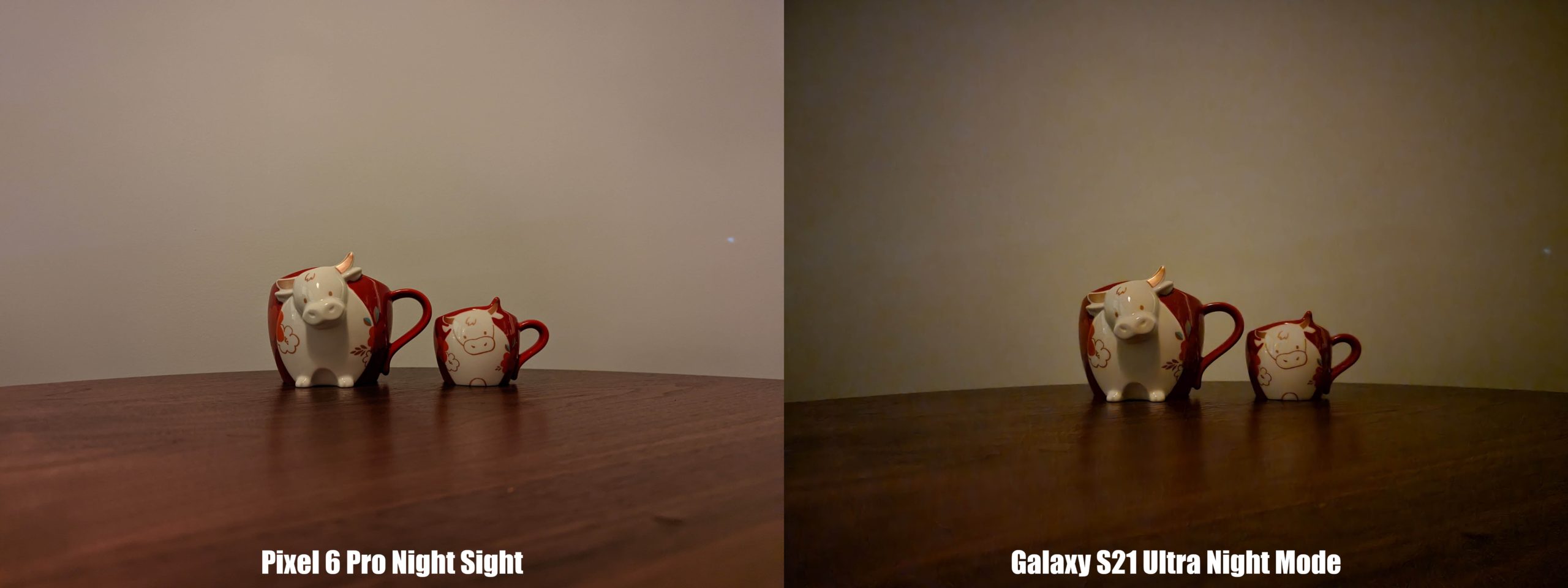
Here’s the same shot again, but this time compared to the Galaxy S21 Ultra. Not only does this comparison provide more context for the iPhone 13’s shot, it also shows where Samsung’s Night Mode could use some work, especially when it comes to exposure and noise caused by a lack of light.
Pixel 6 Pro vs. Surface Duo 2: Ultra Low Light
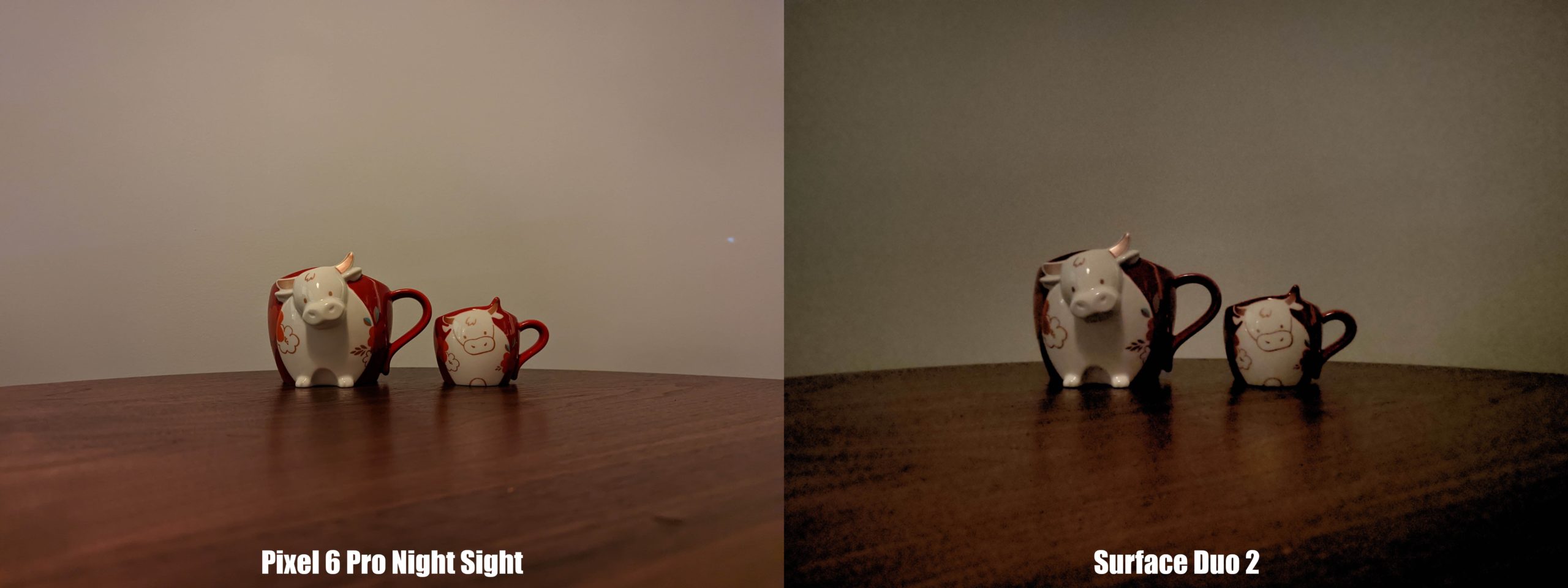
Finally, here’s a head-to-head between the Pixel 6 Pro and the Surface Duo 2, which doesn’t have a dedicated low light or night mode. And the results are about what you’d expect: The Surface Duo 2 really struggles to keep up.
Pixel 6 Magic Eraser
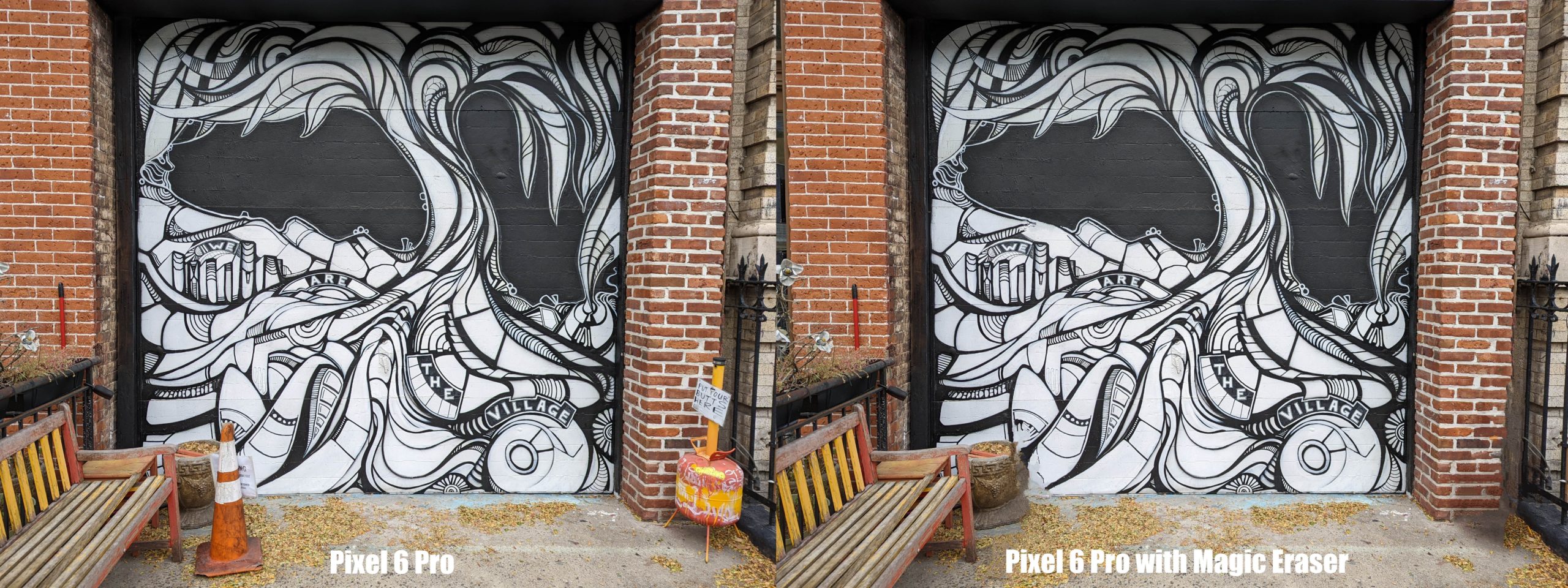
On top of all the improvements to its camera hardware, the Pixel 6 also comes with a few new AI-powered modes and features to play with, including the new Magic Eraser tool. For anyone familiar with Photoshop’s Content Aware Fill feature, Google’s Magic Eraser tool works almost exactly the same, letting you highlight distracting objects in a picture like a photo-bomber or an out of place toy by shading it or circling it with your finger, and then technomagically removing it from the frame.
And while it’s not quite as powerful or precise as Content Aware Fill, I was still able to use it to remove not one, but two objects from the photo above, without really negatively impacting the rest of the photo. If you look closely, you can still see the shadow left behind by the ashtray on the right, and some artifacts from the cone on the left. But with the focus of the picture being on the artwork in the centre, you’re still left with a more focused and less distracting image than you’d otherwise get without Magic Eraser.
Pixel 6 Long Exposure Mode
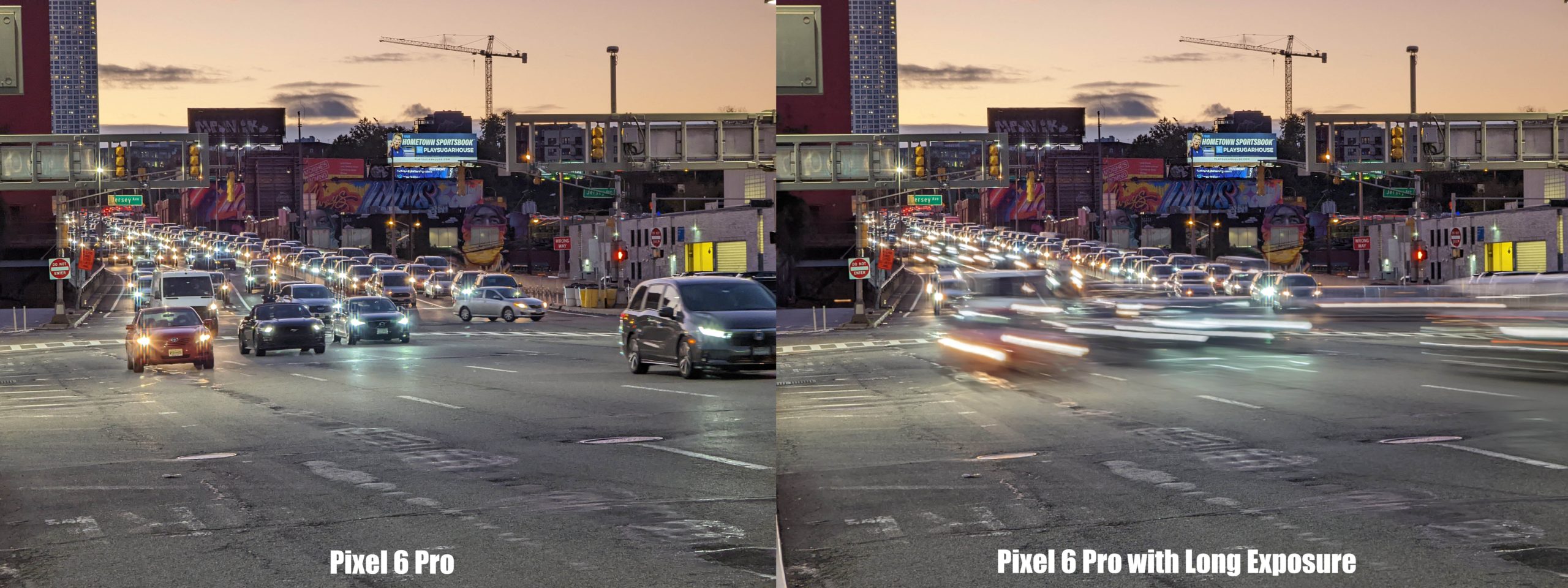
Google’s new Long Exposure mode might be my favourite new photo feature on the Pixel 6, because of how easily it distills the process of taking long exposure shots into a single tap. All you have to do is activate Long Expsoure mode, hold the phone steady, and hit the shutter button, and voila. Suddenly a boring shot of a road and some cars gets colourful streaky headlights and taillights, without having to figure out the correct shutter speed or carry a heavy tripod around.
Long Exposure even works just as well during the day as it does at night, which allows you to create those tranquil water scenes where rivers look like glass and waterfalls turn into smooth, silky fountains.
Pixel 6 Action Pan
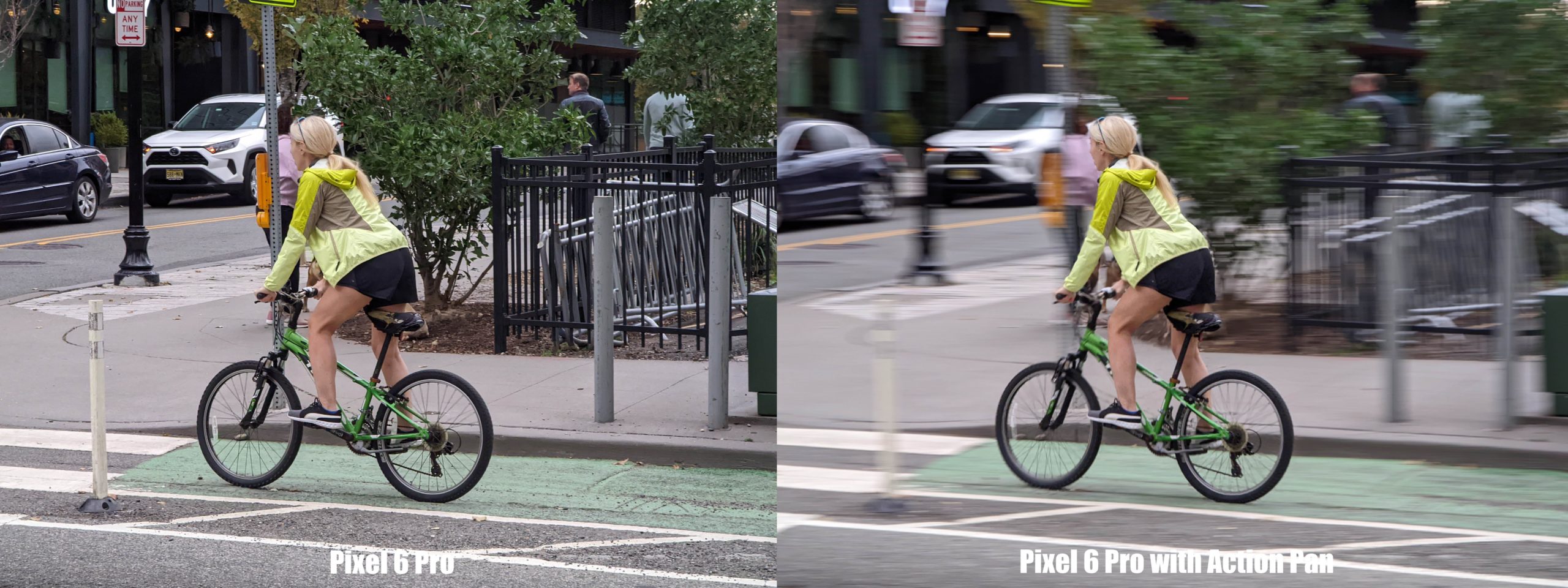
Finally, in order to add a little extra drama to your action shots, the Pixel 6’s Action Pan mode uses a special algorithm to add some creative blur to your shots. The Pixel 6 does the hard work of figuring out how fast the shutter needs to be to freeze the action, while the blur makes adds a sense of speed you wouldn’t get otherwise. You don’t even need to follow your subject the entire time like you would when performing a real action pan, you can just point and shoot, and Google’s software does the rest.
Action Pan also works equally well on people and vehicles like cars or boats, though it can get tripped up on subjects with fuzzier outlines like pets.
And if you have a child who just can’t sit still, Google added a feature called Face Unblur, which uses images captured by multiple cameras at once to make people appear just a bit sharper. Face Unblur is on by default, so it’s always running in the background to help things look as sharp as possible.
